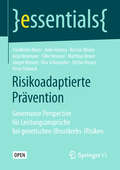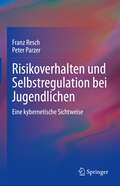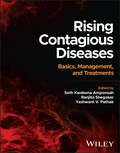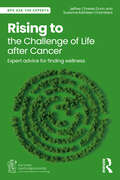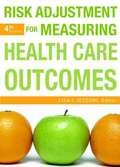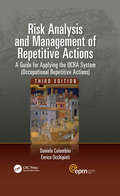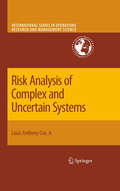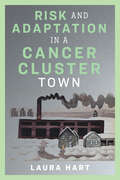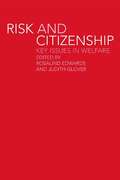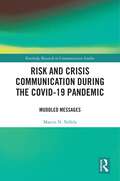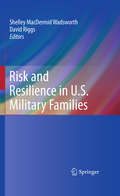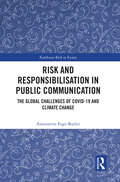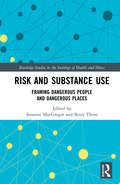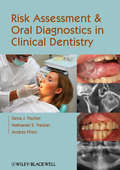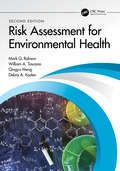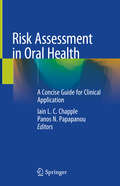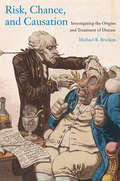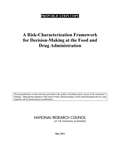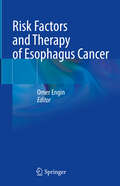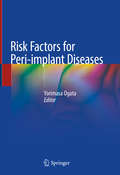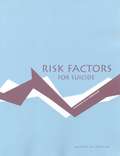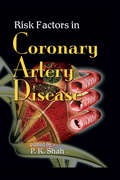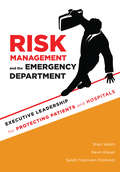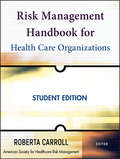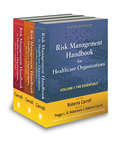- Table View
- List View
Risikoadaptierte Prävention: Governance Perspective für Leistungsansprüche bei genetischen (Brustkrebs-)Risiken (essentials)
by Matthias Braun Friedhelm Meier Anke Harney Kerstin Rhiem Anja Neumann Silke Neusser Jürgen Wasem Rita Schmutzler Stefan Huster Peter DabrockDie vorliegende Studie empfiehlt, Leistungsansprüche für Personen mit interventionsfordernden (Brustkrebs-)Risiken anhand einer neuen Rechtskategorie, der ‚risikoadaptieren Prävention‘, abzubilden. Spätestens seit dem bioinformatischen Innovationsschub (Big Data) kann eine risikoadaptierte Anwendung von prophylaktischen Maßnahmen umfassend gewährleistet werden. Jedoch können die gegebenen Rechtskategorien (primäre Prävention, Vorsorge, Krankenbehandlung) das medizinische Anwendungsfeld nicht adäquat steuern.Die Autoren Friedhelm Meier, Anke Harney, Kerstin Rhiem, Anja Neumann, Silke Neusser, Matthias Braun, Jürgen Wasem, Rita Schmutzler, Stefan Huster und Peter Dabrock haben zusammen im BMBF geförderten Projekt SYSKON. Re-Konfiguration von Gesundheit und Krankheit. Ethische, psychosoziale, rechtliche und gesundheitsökonomische Herausforderungen der Systemmedizin die vorliegende Governance Perspective erarbeitet.
Risikoverhalten und Selbstregulation bei Jugendlichen: Eine kybernetische Sichtweise
by Franz Resch Peter ParzerDiesem Buch liegt der Gedanke zugrunde, dass zunehmende jugendliche Risikoverhaltensweisen - wie Drogenmissbrauch, nicht-suizidale Selbstverletzung und antisoziales oder suizidales Verhalten - es Heranwachsenden ermöglichen, Entwicklungsaufgaben wie Identitätsbildung und Selbstwertregulation zu erfüllen. Narzisstische Selbstausbeutung, Mobilitätsaufgaben, Flexibilität und die Herausforderungen der neuen Medien üben sozialen Druck auf die Eltern aus, lenken ab und belasten ihre psychischen Ressourcen, was wiederum den emotionalen Dialog mit ihren Kindern verändert oder gar zerstört. Erleben Kinder selbst Vernachlässigung und mangelnde emotionale Bindung - und damit fehlende Selbstregulationsfähigkeit - sind Risikoverhaltensweisen die Folge.Das Buch kombiniert verschiedene Sichtweisen aus dem psychologischen, sozialen und metatheoretischen Bereich. Es besteht aus drei Teilen: Entwicklungsprobleme junger Menschen, Diagnose von Risikoverhaltensweisen im nosologischen Rahmen und Darstellung der neuen Morbidität mit einer Zunahme der Symptomprävalenz. Das Buch erörtert auch die Bedrohung durch die Beschleunigung der sozialen Prozesse und die Risiken der postmodernen Gesellschaft.
Rising Contagious Diseases: Basics, Management, and Treatments
by Seth Kwabena Amponsah Ranjita Shegokar Yashwant V. PathakComprehensive yet succinct insight into the prevention, diagnosis, and treatment of infectious diseases including COVID-19, mpox, Ebola, and Lyme disease Rising Contagious Diseases provides basic information about preventing and treating threatening infectious diseases from viral, bacterial, and parasitic sources, including 28 emerging or recurring diseases like COVID-19, mpox, Ebola, bird and swine flu, malaria, Legionnaires', and others. The text highlights molecular surveillance and epidemiology (including zoonotic pathogens or their variants), innovative strategies for pathogen detection, drug and vaccine development, appropriate preventive measures, cost-effective diagnostic procedures (assays), and effective therapeutic strategies. The text is unique due to its broad coverage of today’s infectious diseases, covering several which are not similarly addressed elsewhere, with detailed insight from experts around the world. Composed of 30 chapters of fundamental facts alongside practical and clinical data, Rising Contagious Diseases covers sample topics such as: Re-emergence of certain diseases in recent decades due to dynamic host-pathogen interactions, anthropogenic selection, and climate change How real-time epidemiological surveillance can improve detection of infectious disease outbreaks or new infections of public health importance Up-to-date insight on transmission dynamics, epidemiology, clinical manifestation, advances in diagnostics, and management of covered diseases Effects of disease outbreaks on the world at large, such as through high morbidity and mortality rates and rising healthcare costs With detailed insight on the prevention, diagnosis, and treatment of infectious diseases, Rising Contagious Diseases is an essential reference for health care professionals, academics in the field of microbiology, immunology, infectious diseases, pathology, pharmacology and public health, and undergraduates and postgraduates in related disciplines.
Rising to the Challenge of Life After Cancer: Expert Advice for Finding Wellness (BPS Ask The Experts in Psychology Series)
by Jeffrey Charles Dunn Suzanne Kathleen ChambersRising to the Challenge of Life After Cancer: Expert Advice for Finding Wellness is an easy-to-read self-help guide for people facing cancer diagnosis and treatment. Following an effective Q&A format and based on a unique Wellbeing Essentials framework, it offers a valuable ‘dip in and out’ approach with signposting to evidence-based guidance on major challenges that those diagnosed with cancer and their family and friends may face. If you or someone close to you has had a cancer diagnosis, then this book is for you.With a focus on wellness and taking control, questions addressed include ‘Is there a best way to cope with cancer?’, ‘What strategies can help me make an informed decision about treatment?’, ‘What is prehabilitation and how can this help me?’, and ‘Who am I now?’. The book covers an array of essential guidance from maintaining social health and wellbeing, to accessing care and support in the community. It is written for both those living with or beyond cancer as well as their support network. The book also includes Jeff and Suzanne’s personal stories about their lived experience of cancer and a Resources and Connections section with tips for further information and support.Written by academic experts who are also ‘experts by experience’, this book is indispensable for people with cancer and their families, and anyone wanting to understand more about the condition, as well as health and social care professionals and students of social care, health care and nursing.
Risk adjustment for Measuring Health Care Outcomes
by Lisa I. IezzoniA new chapter on the role of risk adjustment in managing healthcare organizations <p><p> New information on risk factors, including genetics and social and environmental determinants of health <p> Perspectives on electronic health records and new health information technologies <p> Explanations of new statistical methods for comparing provider outcomes and their implications for risk adjustment.
Risk Analysis and Management of Repetitive Actions: A Guide for Applying the OCRA System (Occupational Repetitive Actions), Third Edition (Ergonomics Design & Mgmt. Theory & Applications)
by Daniela Colombini Enrico OcchipintiThis book covers the application of the OCRA (Occupational Repetitive Actions) method. The methods make up a system dedicated to the analysis and management of the risk of biomechanical overload of the upper limbs. The book focuses on the OCRA checklist which presents various models from the most simplified, to the most complex. It describes methods, criteria, procedures and tools on how to perform such an assessment, in line with international standards. The book provides you with the correct methods and tools for prevention of upper limb work related musculoskeletal disorders no matter what the working environment is or what the international standards dictates.
Risk Analysis of Complex and Uncertain Systems
by Louis Anthony Cox Jr.In Risk Analysis of Complex and Uncertain Systems acknowledged risk authority Tony Cox shows all risk practitioners how Quantitative Risk Assessment (QRA) can be used to improve risk management decisions and policies. It develops and illustrates QRA methods for complex and uncertain biological, engineering, and social systems - systems that have behaviors that are just too complex to be modeled accurately in detail with high confidence - and shows how they can be applied to applications including assessing and managing risks from chemical carcinogens, antibiotic resistance, mad cow disease, terrorist attacks, and accidental or deliberate failures in telecommunications network infrastructure. This book was written for a broad range of practitioners, including decision risk analysts, operations researchers and management scientists, quantitative policy analysts, economists, health and safety risk assessors, engineers, and modelers.
Risk and Adaptation in a Cancer Cluster Town (Nature, Society, and Culture)
by Laura HartIn disease cluster communities across the country, environmental contamination from local industries is often suspected as a source of disease. But civic action is notoriously hampered by the slow response from government agencies to investigate the cause of disease and the complexities of risk assessment. In Risk and Adaptation in a Cancer Cluster Town, Laura Hart examines another understudied dimension of community inaction: the role of emotion and its relationship to community experiences of social belonging and inequality. Using a cancer cluster community in Northwest Ohio as a case study, Hart advances an approach to risk that grapples with the complexities of community belonging, disconnect, and disruption in the wake of suspected industrial pollution. Her research points to a fear driven not only by economic anxiety, but also by a fear of losing security within the community—a sort of pride that is not only about status, but connectedness. Hart reveals the importance of this social form of risk—the desire for belonging and the risk of not belonging—ultimately arguing that this is consequential to how people make judgements and respond to issues. Within this context where the imperative for self-protection is elusive, affected families experience psychosocial and practical conflicts as they adapt to cancer as a way of life. Considering a future where debates about risk and science will inevitably increase, Hart considers possibilities for the democratization of risk management and the need for transformative approaches to environmental justice.
Risk and Citizenship: Key Issues in Welfare
by Rosalind Edwards Judith GloverContemporary welfare provision poses serious challenges for social policy. Large and rapid changes are said to be taking place in the way we live, work and relate to each other, characterised by anxiety and insecurity.Risk and Citizenship explores how new and diffrent forms of citizenship are evolving in the context of this 'risk society' and the implications for the development of social policy at both the macro and micro level. This spirited and informed collection of papers by leading analysts addresses key questions related to welfare, citizenship and risk including: the nature of insecurity and social protection; the balance between inequality and egalitarianism; the relationship between governments and citizens; the parameters of citizenship; and the impact of risk assessment and risk management. Risk and Citizenship offers a thought-provoking reading for student, practitioner or policy-maker. It provides: * a review of current debates about risk, citizenship and welfare * in-depth analysis of specific policy initiatives in social security and community care * a new typology of welfare citizenship.
Risk and Crisis Communication During the COVID-19 Pandemic: Muddled Messages (Routledge Research in Communication Studies)
by Martin N. NdlelaThis book examines the challenges of communicating risk and crisis messages during the COVID-19 pandemic to provide recommendations for managing future global health crises. Given that outbreaks, epidemics, and pandemics are global crises that require global solutions, the book suggests that the world community needs to build resilient crisis management institutions and message management systems. Through international case studies, in-depth interviews, textual, content, narrative and document analysis, the book provides comprehensive accounts of how normative risk communication strategies were invoked, applied, disrupted, questioned, and changed during the COVID- 19 pandemic. It explores themes including crisis preparedness, outbreak communication, lockdown messages, communication uncertainty, risk message strategies and the challenges of information disorders to show that trust in supranational and national institutions is crucial for the effective management of future global public health crises. A thorough assessment of the multiple challenges faced by public health authorities and audiences during the COVID-19 pandemic, this book will be of interest to researchers, practitioners, and students in the field of Risk, Crisis and Health Communication and Public Health and Disaster Management.
Risk and Resilience in U.S. Military Families
by Macdermid-Wadsworth Shelley David RiggsWar related separations challenge military families in many ways. The worry and uncertainty associated with absent family members exacerbates the challenges of personal, social, and economic resources on the home front. U.S. military operations in Iraq and Afghanistan have sent a million service personnel from the U.S. alone into conflict areas leaving millions of spouses, children and others in stressful circumstances. This is not a new situation for military families, but it has taken a toll of magnified proportions in recent times. In addition, medical advances have prolonged the life of those who might have died of injuries. As a result, more families are caring for those who have experienced amputation, traumatic brain injury, and profound psychological wounds. The Department of Defence has launched unprecedented efforts to support service members and families before, during, and after deployment in all locations of the country as well as in remote locations. Stress in U.S. Military Families brings together an interdisciplinary group of experts from the military to the medical to examine the issues of this critical problem. Its goal is to review the factors that contribute to stress in military families and to point toward strategies and policies that can help. Covering the major topics of parenting, marital functioning, and the stress of medical care, and including a special chapter on single service members, it serves as a comprehensive guide for those who will intervene in these problems and for those undertaking their research.
Risk and Responsibilisation in Public Communication: The Global Challenges of COVID-19 and Climate Change (Earthscan Risk in Society)
by Antoinette Fage-ButlerThis book explores the connections between risk and responsibilisation in official communication to the public about the global risks of the pandemic and climate change. Our media spheres in the 2020s have been saturated with information about what we should or should not be doing to meet the challenges of the COVID-19 pandemic and climate change. Although the ability of risk communication to ‘responsibilise’ the public is central to its functioning in our societies, this aspect has so far been under-investigated in academia. To address this lacuna, Antoinette Fage-Butler develops a discursive approach to risk communication that focuses on the values that are communicated in risk messages. Examples of official risk communication about the pandemic and climate change from national and transnational contexts are analysed and compared, leading to new empirical findings and theoretical insights about the nature of risk and responsibilisation. Fage-Butler also builds on recent stirrings in the evolving field of risk communication that highlight the importance of cultural and value-related factors. Overall, this book will equip researchers with an approach to risk communication that reflects the complexity of today’s global risk challenges. Risk and Responsibilisation in Public Communication will be of great interest to students and scholars of risk communication, public health and environmental studies.
Risk and Substance Use: Framing Dangerous People and Dangerous Places
by Susanne MacGregor Betsy ThomThis interdisciplinary collection examines the role that alcohol, tobacco and other drugs have played in framing certain groups and spaces as ‘dangerous’ and in influencing the nature of formal responses to the perceived threat. Taking a historical and cross-national perspective, it explores how such groups and spaces are defined and bounded as well as the processes by which they come to be seen as ‘risky’. It discusses how issues of perceived danger highlight questions of control and the management of behaviours, people and environments, and it pays attention to the way in which sanctions and regulations have been implemented in a variety of often inconsistent ways that frequently impact differently on different sections of the population. Bringing together a range of case studies drawn from different countries and across different periods of time, the chapters collected here illustrate issues of marginalisation, stigmatisation, human rights and social expectations. It is of interest to a diverse audience of historians, philosophers, human geographers, anthropologists, sociologists and criminologists interested in substance use and misuse, deviance, risk and power among other topics.
Risk Assessment and Oral Diagnostics in Clinical Dentistry
by Andres Pinto Nathaniel S. Treister Dena J. FischerMany diseases can have an impact upon oral health and/or the safe delivery of dental care. Consequently, oral health care providers need to be comfortable with assessing the risk of providing dental care to their patients with systemic disease as well as the evaluation of oral conditions that may represent manifestations or consequences of systemic disease. Risk Assessment and Oral Diagnostics in Clinical Dentistry aims to enable the dental practitioner to comfortably and capably assess when medical conditions may impact dental care and diagnose oral conditions using routine testing modalities.This clinical guide contains succinct and detailed text with visual aids regarding how to obtain and perform diagnostic tests, how to interpret these tests, and the implications of tests results upon the management of medically complex dental patients and patients with oral conditions. Color photographs show conditions, testing equipment, and test results. An appendix highlights the ten most common oral medicine disorders encountered in dental practice.
Risk Assessment for Environmental Health (Public Health/environmental Health Ser.)
by Mark G. Robson William A. Toscano Qingyu Meng Debra A. KadenUnderstanding risk to humans is one of the most important problems in environmental public health. Risk assessment is constantly changing with the advent of new exposure assessment tools, more sophisticated models, and a better understanding of disease processes. Risk assessment is also gaining greater acceptance in the developing world where major environmental problems exist. Developed in partnership with the Association of Schools of Public Health, this comprehensive text offers a thorough survey of risk assessment, management, and communications as these practices apply to public health. Key Features: Provides a practical overview of environmental risk assessment and its application by discussing the process and providing case studies and examples Focuses on tools and approaches used for humans in an environment involving potential chemical hazards Fully updated, the first part introduces the underlying principles and techniques of the field, and the second examines case studies in terms of different risk assessment scenarios Risk assessment is a core requirement for the MPH degree in environmental health Useful “stories” suitable for case studies
Risk Assessment in Oral Health: A Concise Guide for Clinical Application
by Iain L. C. Chapple Panos N. PapapanouThis book is a wide-ranging guide to risk assessment and risk-based prevention in oral health and dentistry. Readers will find clear explanations of the principles, models, and tools of risk assessment, as well as practical information on risk assessment in relation to periodontal disease, caries, tooth wear, and oral cancer. The lessons that the oral healthcare profession can learn from experiences regarding risk assessment in primary medical care practice, particularly in cardiovascular and diabetes medicine, are highlighted. The closing section focuses specifically on implementation of risk assessment within the dental practice, including training of the oral healthcare team and the need to take into account medicolegal considerations. The book is a very timely addition to the literature, given the move towards wellness- rather than repair-based models of healthcare in Europe and North America and the focus of dental contracts on risk-driven care pathways. It will be of high value for not only practitioners but also professionals and healthcare funding bodies.
Risk, Chance, and Causation
by Michael B. BrackenThe press and other media constantly report news stories about dangerous chemicals in the environment, miracle cures, the safety of therapeutic treatments, and potential cancer-causing agents. But what exactly is actually meant by "increased risk"--should we worry if we are told that we are at twice the risk of developing an illness? And how do we interpret "reduced risk" to properly assess the benefits of noisily touted dietary supplements? Demonstrating the difficulty of separating the hype from the hypothesis, noted epidemiologist Michael Bracken clearly communicates how clinical epidemiology works. Using everyday terms, Bracken describes how professional scientists approach questions of disease causation and therapeutic efficacy to provide readers with the tools to help them understand whether warnings of environmental risk are truly warranted, or if claims of therapeutic benefit are justified.
A Risk-Characterization Framework for Decision-Making at the Food and Drug Administration
by National Research Council of the National AcademiesWith the responsibility to ensure the safety of food, drugs, and other products, the U.S. Food and Drug Administration (FDA) faces decisions that may have public-health consequences every day. Often the decisions must be made quickly and on the basis of incomplete information. FDA recognized that collecting and evaluating information on the risks posed by the regulated products in a systematic manner would aid in its decision-making process. Consequently, FDA and the Department of Health and Human Services (DHHS) asked the National Research Council (NRC) to develop a conceptual model that could evaluate products or product categories that FDA regulates and provide information on the potential health consequences associated with them. A Risk-Characterization Framework for Decision-Making at the Food and Drug Administration describes the proposed risk-characterization framework that can be used to evaluate, compare, and communicate the public-health consequences of decisions concerning a wide variety of products. The framework presented in this report is intended to complement other risk-based approaches that are in use and under development at FDA, not replace them. It provides a common language for describing potential public-health consequences of decisions, is designed to have wide applicability among all FDA centers, and draws extensively on the well-vetted risk literature to define the relevant health dimensions for decision-making at the FDA. The report illustrates the use of that framework with several case studies, and provides conclusions and recommendations.
Risk Factors and Therapy of Esophagus Cancer
by Omer EnginThis book provides updated knowledge on esophageal cancer diagnosis and treatment options. Esophageal cancer has become one of the cancers that can be detected early with the widespread use of endoscopy. Combinations of chemotherapy, radiotherapy and surgical treatment are used in the treatment. Depending on the planning of the surgery, operation is performed in two or three anatomical areas such as abdomen, thorax or cervical region. A good preoperative evaluation and postoperative follow-up and treatment are very important. In the book each stage of the disease is explained by different branches with a multidisciplinary approach. The book addresses professionals in oncology, radiology and surgery.
Risk Factors for Peri-implant Diseases
by Yorimasa OgataIn this book, leading experts from around the world present the latest knowledge on the risk factors for peri-implant diseases and also examine the prevalence, etiology, and treatment strategy. Reports have suggested that a variety of risk factors, including poor oral hygiene, a history of periodontitis, diabetes, smoking, lack of keratinized mucosa, and implant surface topography, are associated with these diseases. Periodontally compromised patients who do not adhere completely to the supportive periodontal therapy have been found to present a higher implant failure rate, and several studies have shown that periodontal pathogens can translocate from periodontally involved teeth to the peri-implant sulci in partially dentate patients, highlighting the importance of periodontal treatment of the residual dentition prior to placement of dental implants. Recently a new concept was proposed as intraindividual variation exists in core microbiota in peri-implantitis and periodontitis. In elucidating the strength of association of peri-implant diseases with all of the risk factors identified to date, the book will be of interest to practitioners and other professionals in the field.
Risk Factors For Suicide: summary of a workshop
by Sara K. GoldsmithThe National Academies Press (NAP)--publisher for the National Academies--publishes more than 200 books a year offering the most authoritative views, definitive information, and groundbreaking recommendations on a wide range of topics in science, engineering, and health. Our books are unique in that they are authored by the nation's leading experts in every scientific field.
Risk Factors in Coronary Artery Disease
by P. K. ShahPromoting developments in the diagnosis, prevention, and treatment of coronary artery disease, this reference furnishes the latest information on new and emerging risk factors for atherothrombotic vascular disorders-analyzing lipid-related and psychosocial risk factors, the genetic aspects of disease, the potential role of infection and inflammatio
Risk Management and the Emergency Department: Executive Leadership for Protecting Patients and Hospitals (ACHE Management)
by Shari WelchThe Emergency Department (ED) is not only the front door to your hospital; it’s where your organization is most susceptible to inefficiencies and adverse outcomes. This handbook provides the knowledge and tools you need to address or avoid the problems inherent in ED healthcare. With an emphasis on the importance of leadership, the authors explore how executives can design systems that minimize risk at the front lines. Real-world examples illustrate strategies that led to a safer, more reliable healthcare environment. Topics covered include: Elements of the ED that can contribute to waits, delays, and errors The role of the board in risk-management strategies Standardization in the ED The power of apologies in emergency medicine Popular myths and misinformation surrounding EMTALA, HIPAA, Stark, and kickbacks Management of the twelve “deadly” clinical scenarios that lead to most ED lawsuits The basics of a lawsuit, including causation, breach, negligence, and damages Survival strategies when legal action is imminent Alignment of clinicians and administrators during legal proceedings
Risk Management Handbook for Health Care Organizations (Jossey-Bass Public Health #30)
by American Society for Healthcare Risk Management (ASHRM)Risk Management Handbook for Health Care Organizations, Student Edition This comprehensive textbook provides a complete introduction to risk management in health care. Risk Management Handbook, Student Edition, covers general risk management techniques; standards of health care risk management administration; federal, state and local laws; and methods for integrating patient safety and enterprise risk management into a comprehensive risk management program. The Student Edition is applicable to all health care settings including acute care hospital to hospice, and long term care. Written for students and those new to the topic, each chapter highlights key points and learning objectives, lists key terms, and offers questions for discussion. An instructor's supplement with cases and other material is also available. American Society for Healthcare Risk Management (ASHRM) is a personal membership group of the American Hospital Association with more than 5,000 members representing health care, insurance, law, and other related professions. ASHRM promotes effective and innovative risk management strategies and professional leadership through education, recognition, advocacy, publications, networking, and interactions with leading health care organizations and government agencies. ASHRM initiatives focus on developing and implementing safe and effective patient care practices, preserving financial resources, and maintaining safe working environments.
Risk Management Handbook for Health Care Organizations, 3 Volume Set
by American Society for Healthcare Risk Management Roberta CarrollContinuing its superiority in the health care risk management field, this sixth edition of The Risk Management Handbook for Health Care Organizations is written by the key practitioners and consultant in the field. It contains more practical chapters and health care examples and additional material on methods and techniques of risk reduction and management. It also revises the structure of the previous edition, and focuses on operational and organizational structure rather than risk areas and functions. The three volumes are written using a practical and user-friendly approach.
